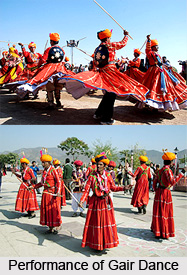 Gair dance is one of the popular folk dances practiced in the Rajasthan state of India. It is one of the many dance forms of the Bhil community of this Indian state. It is mainly performed by the community at the festival of Holi. Colourful costumes, traditional instruments and captivating dance steps are the highlight of this dance. To enjoy this folk art form various viewers from different corners of the world flock to the state every year.
Gair dance is one of the popular folk dances practiced in the Rajasthan state of India. It is one of the many dance forms of the Bhil community of this Indian state. It is mainly performed by the community at the festival of Holi. Colourful costumes, traditional instruments and captivating dance steps are the highlight of this dance. To enjoy this folk art form various viewers from different corners of the world flock to the state every year.
Performance of Gair Dance
This folk dance is performed by both male and female. However, several differences can be observed in the performance of men and women in this dance. Usually, the dancers dance in a big circle with wood stick in there hands. The dancers move in and out a big circle and beat their sticks to create the rhythm when they turn. They move first in clockwise then in anti-clockwise direction. According to rhythm, they perform various steps and take turns in-between.
Sometimes, it is performed exclusively by men folk. At that time, a series of half-swirls make up a simpler version of the dance. Depending on the dancer"s ability and proficiency, it is danced with a series of intricate pattern steps. The striking of the sticks gives the dance a vigorous character and a consistent tempo.
The musical instruments that accompany this folk dance comprise of dhol, nagada, and dholak. The melodious song and enchanting background music encourages one to dance with the beat.
Variations of Gair Dance
Some of the variations of Gair dance are the Dandi Gair found in the Marwar region and Geendad found in the Sehkhawati region of Rajasthan.
Costumes of Gair Dance
Generally, the men wear long, pleated tunic that open out into full length skirts as they move first in clockwise then anti clockwise directions. The Bhil folk perform this dance by wearing colourful dresses and carrying swords, arrows and sticks.
Performance of Fire Dance on Various Occasions
In addition to Holi, it is performed any time as a form of entertainment. Janmastami is another occasion when this dance is performed. Both the festivals are incomplete without the performance of this traditional dance.



















